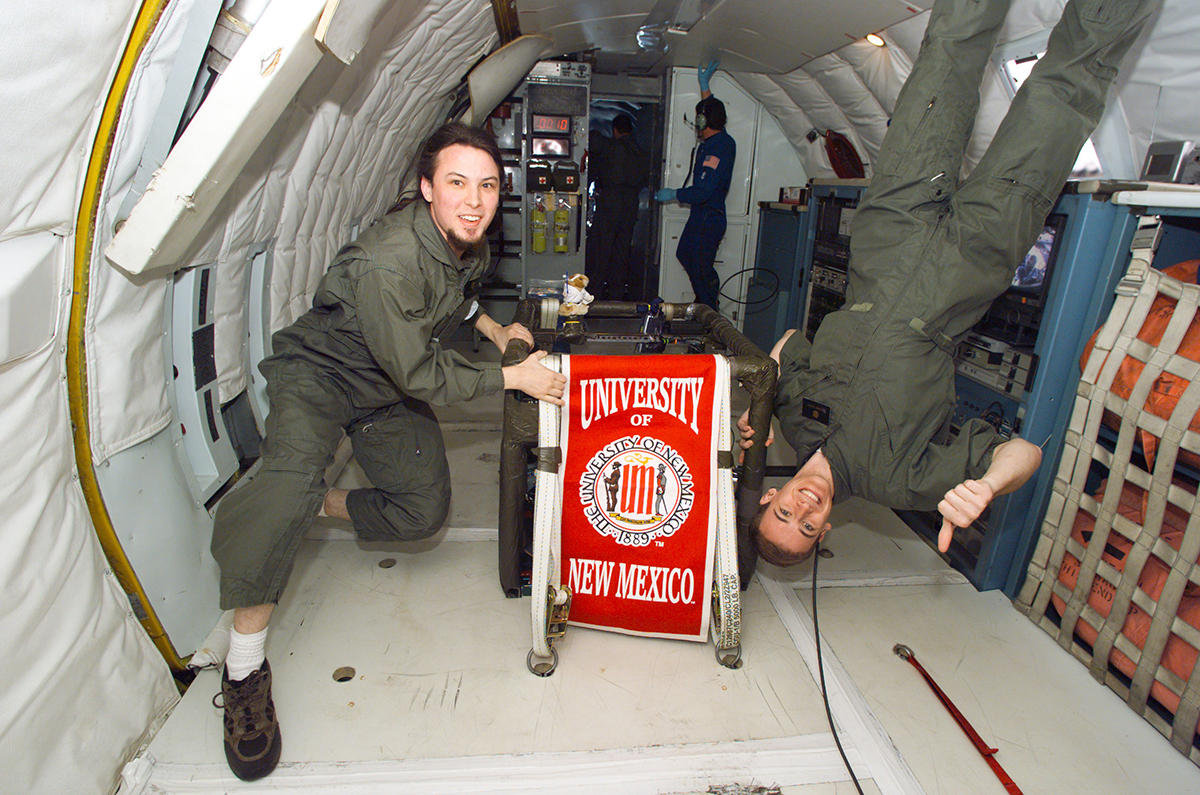Recent News
UNM Engineering team wins ASEE best paper for work on first-year engineering course
July 17, 2025
New director will enhance interdisciplinary engineering learning opportunities
July 2, 2025
Final SIRI cohort visits UNM campus
June 30, 2025
Perfetti receives ANS Landis Engineering Achievement Award
June 26, 2025
News Archives
Albuquerque native, UNM alum part of history-making team to achieve fusion
January 30, 2023 - by Kim Delker

Daniel Casey (left) as a student at UNM with fellow nuclear engineering student Thomas Quirk at the microgravity university KC-135 simulation.
Daniel Casey was first intrigued by the concept of fusion in high school, getting a chance to see the Sandia National Laboratories Z machine in action.
“It blew my mind and got into my head,” he said. “I was really interested in the fusion story."
Even though he had a passion for fusion, he probably never imagined he would achieve what he has to date: being part of the team late last year to make history by achieving fusion at the Lawrence Livermore National Laboratory’s (LLNL) National Ignition Facility (NIF).
Secretary of Energy Jennifer Granholm called the achievement “one of the most impressive achievements of the 21st century” that strengthens our national security by providing a way to safely replicate nuclear testing and moving us closer to zero-carbon energy.
Casey, a physicist studying the properties and performance of inertial confinement fusion implosions at the National Ignition Facility, was born and raised in Albuquerque, graduating from Eldorado High School, so even though UNM was a familiar presence, it may not have been fully appreciated until he arrived on campus.
“I realized we had this amazing resource right here and it was not far from where I was,” he said.
Despite not being born into a family full of physicists or engineers (his dad was in the printing industry and his mom was a dental hygienist), Casey followed his passion to The University of New Mexico, majoring in nuclear engineering. He earned his bachelor’s degree in 2005.
He found a home within the Department of Nuclear Engineering, working with professors like Mohamed El-Genk and Gary Cooper, and having a chance to work on the UNM nuclear reactor. Cooper hired him to work on his Sandia contract, which was in support of Sandia's inertial confinement fusion program (a pulsed-power based version of Livermore's laser-powered version). Casey said the experience as an undergraduate gave him opportunities few other engineering programs could have provided, preparing him for his current career.
“I have a lot of great memories of UNM,” Casey said.
Although Cooper points out that UNM tried to keep Casey in the nuclear engineering program for his graduate studies, he ultimately chose MIT, earning his Ph.D. in 2012 and joining LLNL at the NIF later that year.
One could say that achieving fusion has truly been Casey’s life work, even while he was still a student. His Ph.D. dissertation, titled “Diagnosing Inertial Confinement Fusion Implosions at OMEGA and the NIF Using Novel Neutron Spectrometry,” was the first doctoral thesis to emerge from the NIF (which came online in 2009) and is considered foundational work in the fusion energy field.
Casey describes the accomplishment of achieving fusion as less of an “a-ha” moment of discovery and celebration and more of a culmination of many breakthroughs from generations of scientists like himself.
“There wasn’t really any moment, but more of a series of incremental steps,” he said. “The first person I told was my four-year-old son at breakfast.”
The breakthrough was part of a team effort of around 1,000 people. (There was at least one other School of Engineering alum on the project at NIF: Kelly Hahn, who earned three degrees from the Department of Electrical and Computer Engineering: a bachelor's in 1999, a master's in 2002 and a Ph.D. in 2006. In 2021, Hahn was part of a team involved in a key milestone on the journey to achieving fusion.)
As much as Casey and others at the NIF have accomplished to reach this historical development, he said this is only the beginning, with years more work to go before fusion can be considered a viable energy source.
“What we did is basically take a laser that is as big as three football fields and focus its energy to a point the size of a strand of hair,” he said. “We were able to generate more energy than it took to create it. And now what we have to do is dial that up as far as we can. We did it once, but we need to do that hundreds of times a minute.”
The NIF facilities, which are the most advanced in the world, are capable of firing the laser every couple of hours and performing a target shot roughly once or twice per day, so the capabilities needed are far in the future.
“It’s like the Wright Brothers, where they were able to fly but their airplane was not practical. It’s a demonstration of what can be done, so that’s the significance. We proved we could do it.”
Casey said that as an experimental physicist, he is generally not in the limelight, so the international media attention (including NIF being featured on “60 Minutes”) since the announcement has taken some adjustment.
“I’ve probably done six or seven interviews so far,” he said. “It’s been a lot of fun seeing the press and the public so engaged in this topic. My family has really been into it.”
When he is not working, he enjoys taking advantage of a benefit of living in California by engaging in water activities like kayaking and boating, something he couldn’t do in the high desert where he grew up.
Although the challenges to the next steps in the fusion story are many, Casey finds the work fun and invigorating.
“These are problems worth solving. This field has always been fascinating. It’s like solving puzzles,” he said. “It’s hard to imagine myself anywhere else.”
